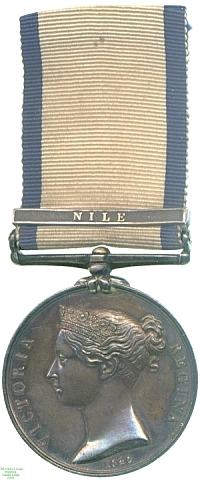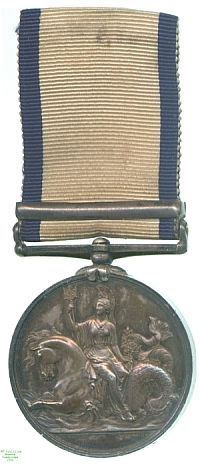
Obverse, a bust of Queen Victoria

Reverse, Britannia with a trident seated sideways on a seahorse

Obverse, a bust of Queen Victoria |

Reverse, Britannia with a trident seated sideways on a seahorse |
Just as in 1848 the extensive land campaigns of the Napoleonic Wars and the other conflicts of the pre-Victorian era were recognised by the issue of the Military General Service Medal, those serving in the Navy at the time were recognised with the Naval General Service Medal. As with the Army equivalent and the East India Company's related award, many of the battles for which the medal was awarded had been fought so long ago that few if any claimants survived.
In addition, bars were awarded for many actions whose significance and size were, despite the heroism displayed by those involved, relatively minor. The result was that many of the bars were issued in tiny numbers, with some combinations all but unique, and the medals command a very high price among collectors because of this rarity and individuality. This in turn, along with the manufacture in most cases of more bars than were eventually issued, has led to the `improvement' of many common awards where recipients' names are shared with those present at `rarer' battles. The medal also shares with the Military General Service and Army of India Medals the oddity that Queen Victoria, whose portrait they bear, was not the ruler under whom the battles for which it was awarded were fought.
One of then-General Napoleon Bonaparte's earlier plans against the British Empire during the French Revolutionary Wars was to threaten India by the capture of Egypt, and to attempt to open a canal between the Mediterranean and the Red Sea. A French expedition arrived in the country in 1798, and British forces were sent in pursuit under Rear-Admiral Horatio Nelson.
The fleets met in Aboukir Bay on the night of 1 August 1798, and Nelson was able to approach from windward so that French ships to the lee could not sail up to support their fellows. As a result Nelson was able to demolish the French line ship by ship, and the French fleet was almost entirely sunk or captured with only 218 casualties on the British side. The victory secured Nelson's reputation, but also led to Bonaparte's return to France to stage the coup that made him First Consul.
This medal was awarded to Leading Man Joseph Rickerd, who fought in the battle aboard HMS Audacious. Although he had to wait half a century for this medal, he may have also received the more contemporary award issued by Nelson's prize agent, Alexander Davison. That Rickerd was present has been verified and the Medals Roll confirms the issue of his NGSM. Lester Watson acquired it at some point before 1928.